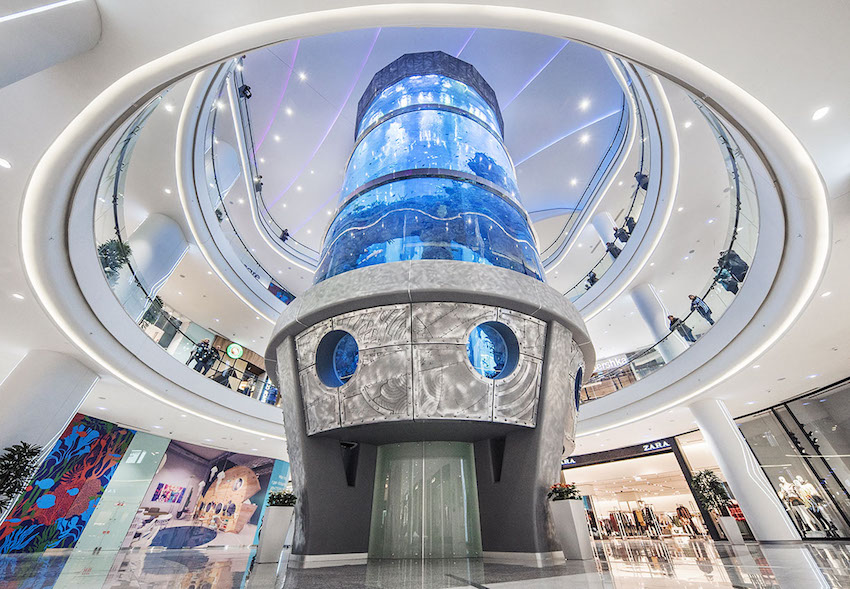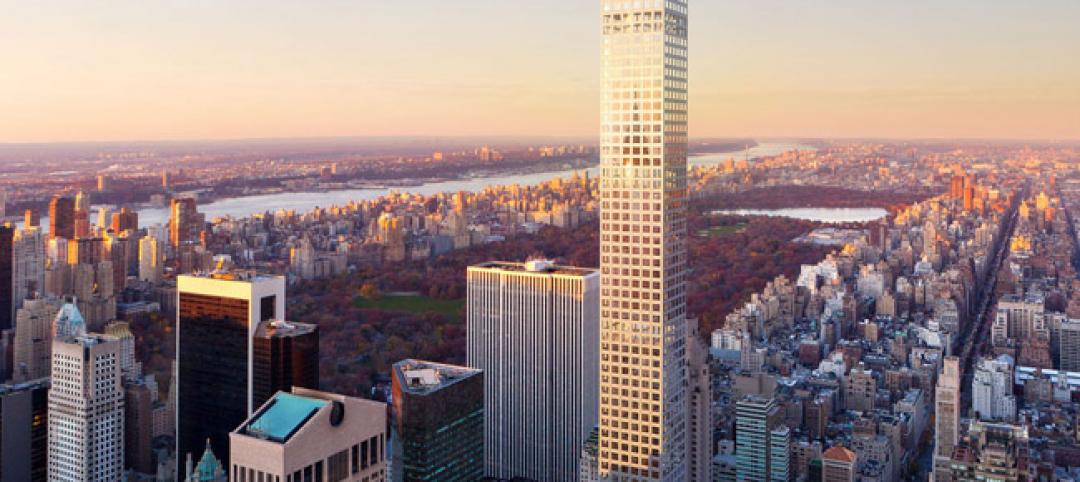The new Oceania Mall in Moscow, Russia is now home to the tallest cylindrical aquarium in the world. Designed and built by International Concept Management (ICM), the 24-meter-tall, 10-meter-wide acrylic aquarium serves as the centerpiece of the new mall, immersing guests in an underwater environment.
The tank holds 900,000 liters of saltwater and was built using 56 pieces of acrylic. Once the individual pieces arrived on site, they were bonded together in specially built technical rooms. Once completed, the largest crane in Russia was needed to lift the massive bonded aquarium pieces into place in the mall. The process, from design to completion, took about 15 months to complete.
Visitors to the mall can enjoy the aquarium from afar, or they can take a hydraulic elevator, the largest in the world, up through the aquarium to get the best view of the 3,200 artificial corals and 50 different species of sharks, rays, and fish found in the tank. The elevator lets its passengers off at the top floor of the mall where they can exit via a walk-through tunnel.
ICM used a filtration system with a modular design so any component can be adjusted without altering the function of the others. The system is located beneath the aquarium and was designed to be hydraulically stable to maximize the integrity of the aquarium.
For more information on the Oceania Mall aquarium, click here.
Related Stories
| Nov 24, 2014
Must see: Plans released for underwater city that could house 5,000 people
The design centers around a floating, 500-meter-wide sphere linked to a resource center on the ocean floor via a 15-kilometer, helix-shaped path.
| Nov 18, 2014
New tool helps developers, contractors identify geographic risk for construction
The new interactive tool from Aon Risk Solutions provides real-time updates pertaining to the risk climate of municipalities across the U.S.
| Oct 29, 2014
Better guidance for appraising green buildings is steadily emerging
The Appraisal Foundation is striving to improve appraisers’ understanding of green valuation.
| Oct 27, 2014
Report estimates 1.2 million people experience LEED-certified retail centers daily
The "LEED In Motion: Retail" report includes USGBC’s conceptualization of the future of retail, emphasizing the economic and social benefit of green building for retailers of all sizes and types.
| Oct 16, 2014
Perkins+Will white paper examines alternatives to flame retardant building materials
The white paper includes a list of 193 flame retardants, including 29 discovered in building and household products, 50 found in the indoor environment, and 33 in human blood, milk, and tissues.
| Oct 15, 2014
Harvard launches ‘design-centric’ center for green buildings and cities
The impetus behind Harvard's Center for Green Buildings and Cities is what the design school’s dean, Mohsen Mostafavi, describes as a “rapidly urbanizing global economy,” in which cities are building new structures “on a massive scale.”
| Oct 15, 2014
Final touches make 432 Park Avenue tower second tallest in New York City
Concrete has been poured for the final floors of the residential high-rise at 432 Park Avenue in New York City, making it the city’s second-tallest building and the tallest residential tower in the Western Hemisphere.
| Oct 12, 2014
AIA 2030 commitment: Five years on, are we any closer to net-zero?
This year marks the fifth anniversary of the American Institute of Architects’ effort to have architecture firms voluntarily pledge net-zero energy design for all their buildings by 2030.
| Sep 24, 2014
Architecture billings see continued strength, led by institutional sector
On the heels of recording its strongest pace of growth since 2007, there continues to be an increasing level of demand for design services signaled in the latest Architecture Billings Index.
| Sep 22, 2014
4 keys to effective post-occupancy evaluations
Perkins+Will's Janice Barnes covers the four steps that designers should take to create POEs that provide design direction and measure design effectiveness.















